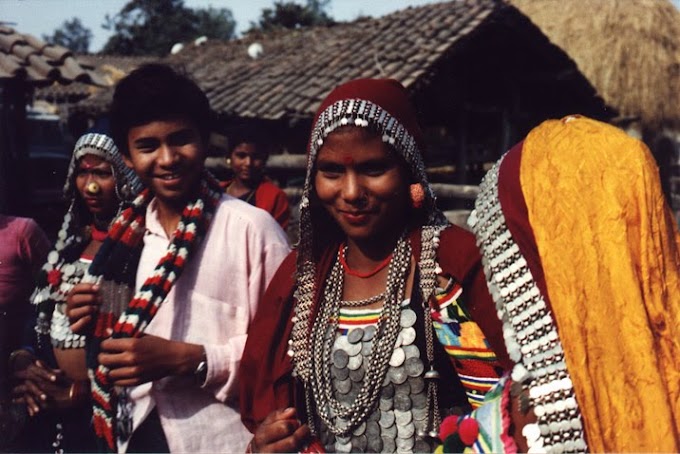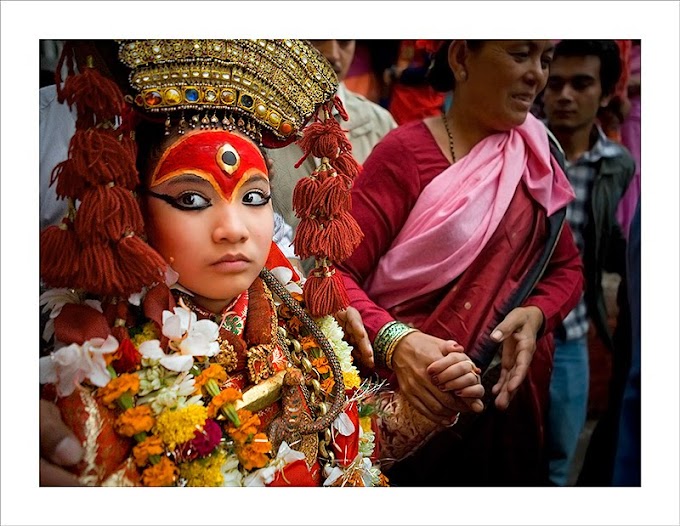Tharu people
The Tharu people mainly live in the Surkhet Valley in the west mountain region, Chitwan Valley, Dang Valley,Deukhuri Valley,Sindhuli and Udyapur in Inner Terai Valleys of Nepal and the Terai plains on the border of Nepal. The population of Nepal is 28,287,147 (July 2006 est.), of which the Tharu people make up 6.6%. A smaller number of Tharus live in India, mostly in Champaran District of Bihar and in Nainital District of Uttarakhand.
Description
The Tharu is the largest and oldest ethnic group of the Terai region (southern plains along the length of Nepalese foothills), living in villages near jungles in regions that were isolated over the millennium, allowing them to develop aunique culture.
History
According to Nepali author Subodh Kumar Singh, a series of invasions by the other races,from north India across the border and from hills and mountains of Nepal, eroded the influence of the indigenous Tharus. In 1854 Jung Bahadur, the first Rana prime minister of Nepal, developed the Mulki Ain, a codification of Nepal's indigenous legal system which divided society into a system of castes. The Tharus were placed at next to the bottom(lowest touchable,above untouchables) of the social hierarchy. Their land was taken away, disrupting their community and displacing the people. In the 1950s, World Health Organisation helped the Nepalese government eradicate malaria in the Terai region. This resulted in immigration of people from other areas to claim the fertile land, making many Tharus virtual slaves of the new landowners and developing the kamaiya system of bonding generations of Tharus families to labour.
Lifestyle
Some Tharu live in longhouses, which may hold up to 150 people. The longhouses are built of mud with lattice walls. They grow barley, wheat, maize, and rice, as well as raise animals such as chickens, ducks, pigs, and goats. In the big rivers, they use large nets to fish.
Because the Tharu lived in isolation in malarial swamps until the recent use of DDT, they developed a style of decorating the walls, rice containers and other objects in their environment. The Tharu women transform outer walls and verandahs of their homes into colorful paintings said to be dedicated to Lakshmi, the Hindu goddess of prosperity and fertility.
Language
There is no one Tharu language unifying Tharu communities in different parts of Nepal. Instead Tharu speak variants of Urdu and Awadhi in western Nepal, of Bhojpuri in and near central Nepal, and of Maithili in and near eastern Nepal. More standard versions of these dialects are widely spoken by non-Tharu neighbors in the same areas so that there are no important linguistic barriers between Tharus and their neighbors. However there are linguistic barriers between these dialects standing in the way of communication between Tharus from different regions. Hindi has been proposed as a lingua franca for communication across the Terai in general may make as much sense in that role for Tharus as others, although the Pahari (hill) community -- where Nepali is the lingua franca -- considers elevation of the official status of Hindi an insult to Nepalese sovereignty.
Genetic resistance to malaria suggests that Tharu were already living in the Terai before Indo-Europeans arrived, raising the question what they may have been speaking at the time. Nevertheless if any linguistic features survive from that era, they have not been documented.
Marriage system of Tharu people
A marriage is often arranged starting with the pregnancy of two women. If the two women give birth to opposite sex babies, the two babies are to be married if they grow up as friends. If a boy comes of age and leaves his wife to seek a new one, it is often difficult because most of the girls and boys are already proposed to get married. Elopement takes place in the society because of big differences in ages of husbands.
Religion
The Tharu are adherents of Hinduism, but also held Islamic, Animist and Buddhist beliefs. Small numbers have converted to Buddhism in the recent years. Such syncretic practices have led Tharu to practice folk Hinduism. With the advent of religious freedom, others have converted to Christianity and there are a variety of congregations active in the various districts where Tharus are found.
Traditional Tharu worship various gods in the form of animals such as dogs, crow, ox and cows. Such gods are seen in Hinduism. Every village has their own deity, commonly known as Bhuinyar. Tharu in East Nepal call their deity Gor-raja.
Most Tharu households own a statue of a traditional god. Family members often offer animal's blood sacrifices to appease the god. Animals such as pigeons and chickens are used for sacrificial purposes. Milk and silk cloth are also used. Many Tharu would also use the blood of one of the male members in the family for such rituals. Such rituals are conducted through ceremonies, and superficial cuts are made forehead, arms, throat, legs, and/or chest.
The gods are believed to have the ability to heal diseases and sickness. According to traditional legend, gods are given a bhakal, a promise of something, on condition that the sickness is cured, in any events of misfortunes, plagues and horror dreams. A relative's death is an event of great significance among Tharu, and rituals conducted varies in accordance to regions.
Tharu would approach shamans as doctors, known as Guruba. Such shamans use Buddhist medicines to cure illness. Shamans will also try to appease gods through incantations, beating drums and offering sacrifices. The Tharu believe sickness comes when the gods are displeased, and the demons are at work.
Buddhist converts among the Tharu are found in Saptari, Siraha and Udaypur. Currently it is believed that there are more than one dozen of Buddhist monks and novices among the Tharus. Such practice was possibly based on the fact that they were inspired by the discovery of Lord Buddha as a member of the Tharu tribe.
97.63% of the ethnic Tharu were Hindu according to the 2001 Census of Nepal, whereas 1.95% were Buddhists.







Great post like this must be highly recommended.
ReplyDeleteannapurna circuit trekking Annapurna Circuit Trekking Holiday - rightly known as Nepal's classic trek - offers more variety than any other equivalent length trek, taking us through virtually every type of scenery that Nepal has to offer.
The statement that Tharu people don't have their own language is totally misleading.Of course, they have their own language - Tharu language and they use even in Eastern Terai.
ReplyDeleteTharus are innocent people who live in harmony with nature. They should not be relegated to undeveloped and uncivilized status.
ReplyDeleteTharus are innocent people who live in harmony with nature. They should not be relegated to undeveloped and uncivilized status.
ReplyDeleteTharus are innocent people who live in harmony with nature. They should not be relegated to undeveloped and uncivilized status.
ReplyDeleteReally you are a good blogger, i regularly follow your blog. I have red your most of the blog like Everest 3 pass trek, Ghorepani poonhill trek, and about different Mountain trek etc.
ReplyDeleteHow To Make Money From Free Betting Sites in Nigeria
ReplyDeleteWe have done everything หาเงินออนไลน์ you need to make money from betting in Nigeria. Find the best betting sites and get your welcome bonus now.